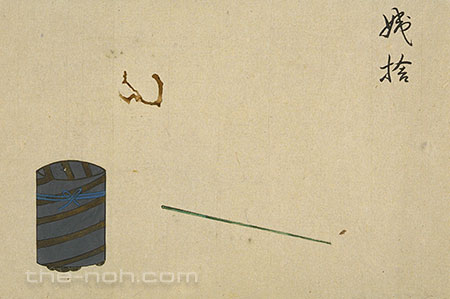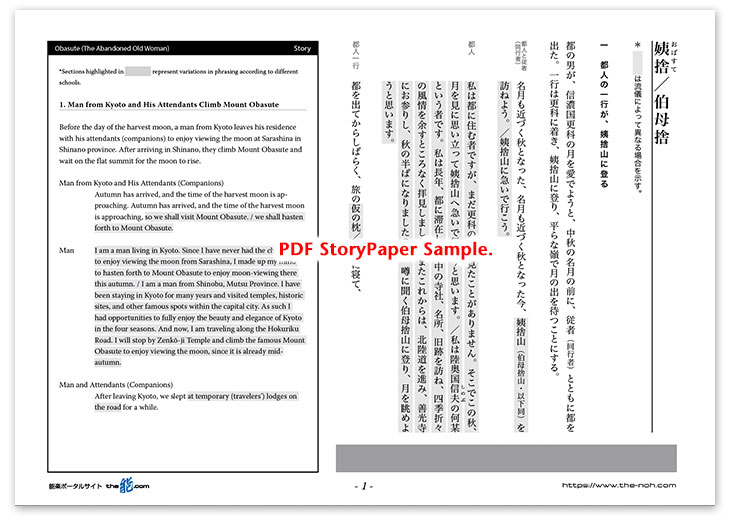
 Obasute (The Abandoned Old Woman)
Obasute (The Abandoned Old Woman)

![]()
One autumn, a man living in Kyoto happened to get the idea to go to Sarashina in Shinano Province, which is famous for its view of the beautiful moon. With his attendants (companions), he climbs Mount Obasute on the day of the harvest moon. He has reached the flat summit of the mountain and is waiting for the moon to rise, when a middle-aged woman approaches the man and speaks to him. The woman introduces herself as a local of the Sarashina region and mentions that the moon tonight will shine even more beautifully and brightly than usual. The man from Kyoto asks the woman about the location in which, according to rumor, an old woman was abandoned and left to die. The woman tells him the story of an old woman, abandoned on this mountain, who recited this poem: “Nothing can ease my saddened heart, here in Sarashina, when I look up the moon shining over Mount Obasute [literally, “Abandoning-Old-Woman Mountain].” She then points to her grave. Now more than ever, the lonely, desolate atmosphere of the place suggests the lingering earthly attachments of the old woman. At this point, the woman says that she will appear later that night, along with the moon, to entertain the man with her songs and dancing. She then reveals that she is indeed the old woman who was abandoned on this mountain and disappears behind a tree. [Interlude]
After the old woman vanishes into thin air, a local man from Sarashina appears and recounts in detail the legend of the abandoned woman to the man from Kyoto. He suggests that the man stay there overnight. Eventually night falls, and the moon shines brightly in the crisp, clear sky. While the man from Kyoto is enjoying the view of the moon, the ghost of the old woman in white robes appears. She lauds the beauty of the moon in this place and narrates a Buddhist story associated with the moon. While she pines for bygone days and performs a dance, day starts to break. The man leaves the mountain and the old woman, having seen him off, is left alone again, just as in olden times when she was abandoned to die on the mountain.
![]()
Among the “old women” plays that require advanced skills to perform, this Obasute, along with Higaki and Sekidera Komachi, are called the Three Old Women pieces. They are considered to be the most advanced, esoteric pieces among all Noh dramas and therefore, they are hardly ever performed. Actors are permitted to perform Obasute at an earlier stage in their Noh career compared to other two pieces, which generates more opportunities to see it performed.
The composition of Obasute is believed to be have been inspired by a poem in Kokin Wakashū (Collection of Japanese Poems of Ancient and Modern Times), “Nothing can ease my saddened heart, here in Sarashina, when I look up the moon shining over Mount Obasute,” as well as the legend of the abandoned old woman that has been passed down in the Sarashina region in Shinano Province. The legend of abandoning an old woman appears in ancient story books, such as Yamato Monogatari (Tales of Yamato), Konjaku Monogatari (Anthology of Tales from the Past), and Toshiyori Zuinō (The Poetic Genius of Toshiyori). In Yamato Monogatari and Konjaku Monogatari, a man who was pressured by his wife abandons his aged aunt, whom he looked up to as his mother, in the mountains. However, he regrets his action, returns to takes her back with him, and writes a poem about it. Toshiyori Zuinō includes a story of an elderly woman, who had adopted her niece, being abandoned in the mountains and composing a poem there. It is not clear in this story whether the niece ends up taking the old woman back home with her. In this Noh play, the old woman writes a poem about her feeling and passes away on the mountain.
Although Ai Kyōgen relates the tragic legend of how the old woman was abandoned to die, that story serves merely as the backdrop of this play. The highlight of this piece comes in the second half of the drama: the unworldly night scene created by the pure, calm solitude of the mysterious old woman, appearing like a nymph of the moon on the mountain illuminated by the bright light of the harvest moon.
Lengthy explanations are probably unnecessary to enjoy this esoteric piece of drama, which only an extremely limited number of actors are allowed to perform. We hope you immerse yourself in the world of Obasute and enjoy the best of best performances.
STORY PAPER : Obasute (The Abandoned Old Woman)
Story Paper presents noh chant stories in modern speech, with story outlines, highlights and more using Adobe PDF format, which can print out and zoom in. Print out the pages and take them with you when you see the actual noh performance.

The copyright of Story Paper is held by the Noh.com. Story Paper is for individual use only. It is prohibited by the copyright law to distribute or publish printed-out Story Paper pages without prior consent. For more information, check the credit and disclaimer pages.



 [Obasute (The Abandoned Old Woman) : Story Paper PDF : 565KB
[Obasute (The Abandoned Old Woman) : Story Paper PDF : 565KB